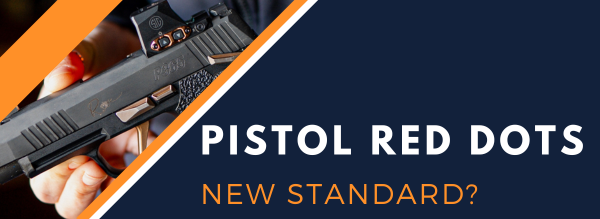Red Dot Optics for Pistols: The New Standard?
Over the past few years, pistol red dot optics have gone from niche to nearly mainstream. Once reserved for competition shooters and tactical units, red dot optics are now showing up on everything from carry pistols to duty guns—and manufacturers are taking note. With factory slide cuts, optics-ready models, and even pistols that ship with optics installed, the writing is on the wall: red dots are here in a big way.
But does that mean they’re the new standard? Or are they just the latest trend? Let’s break it down.
A Quick Look Back
Red dot optics on rifles have been standard fare for decades, but on pistols, adoption was slow. Early models were bulky, expensive, and not durable enough for rough use. Fast forward to today and technology has caught up: modern micro red dots are smaller, tougher, and have battery lives measured in years—not days.
Brands like Trijicon, Holosun, Aimpoint, and Sig Sauer have led the charge with rugged, compact models built specifically for handguns. And with law enforcement and military units giving them the green light, it was only a matter of time before civilian gun owners followed suit.
Why Are Red Dots So Popular Now?
1. Faster Target Acquisition
A red dot lets you keep your eyes on the target—not the front sight. With proper presentation and practice, many shooters find they can get on target quicker and maintain focus better with a red dot than with iron sights.
2. Improved Accuracy at Distance
Red dots excel at longer handgun ranges. It’s much easier to place precise shots at 25+ yards when you’re not fighting sight alignment or tiny irons.
3. Aging Eyes Welcome
Let’s face it: eyesight isn’t forever. Pistol optics make it much easier for older shooters or those with vision issues to shoot more accurately and confidently.
4. Low-Light Advantage
Pair a red dot with a good weapon light and you’ve got a serious advantage in low-light environments. The bright dot is easy to see, even when irons would be nearly invisible.
What’s the Catch?
Red dots aren’t a magic solution. There are some drawbacks and a learning curve:
1. Cost
An optic-ready pistol might not break the bank, but adding a quality red dot can cost anywhere from $200 to $600+. Throw in tall backup iron sights and mounting hardware, and the price creeps up.
2. Training Time
There is a learning curve. Finding the dot during the draw takes practice. If you try to treat it like irons, you might get frustrated. However, with consistent reps, most shooters adapt quickly.
3. Durability and Battery Life
Modern red dots are much more rugged, but they’re still electronics. Batteries die. Glass can break. Optics can fail. That’s why many red dot users still run co-witnessed iron sights as a backup.
4. Holster Compatibility
Optic-equipped pistols often need specialized holsters. Many companies have caught up, but it’s something to consider if you’re already invested in gear.
Are Red Dots the New Standard?
It’s starting to look that way. Here’s why:
- More Pistols Are Optics-Ready: Nearly every major handgun manufacturer offers red-dot-ready models. Some even come with adapter plates or bundled optics out of the box.
- Law Enforcement Adoption is Rising: Agencies across the country are making the switch, especially for patrol and SWAT officers. That always has a downstream effect on civilian markets.
- Training and Support Are Growing: Red dot-specific classes, drills, and online resources are more accessible than ever, helping shooters make the transition.
Who Should Consider One?
- Concealed Carriers looking to improve speed and accuracy.
- Home Defense Shooters who want low-light advantage.
- Competitors who want to up their game.
- New Shooters who struggle with irons.
- Aging Shooters who want to stay sharp.
Final Thoughts
Are pistol red dots the new standard? For many shooters—yes. They’re not just a trend anymore; they’re a legitimate performance upgrade that, once mastered, can make you a faster and more accurate shooter.
That said, red dots aren’t a one-size-fits-all solution. They require time, training, and an understanding of the system. But if you’re willing to put in the reps, a pistol red dot might just change how you shoot for the better.
What do you think? Have you made the switch—or are you sticking with irons? Drop your thoughts below.
